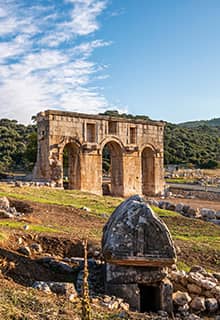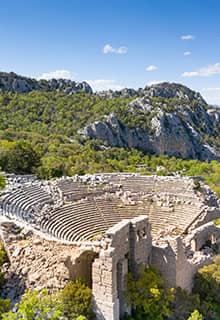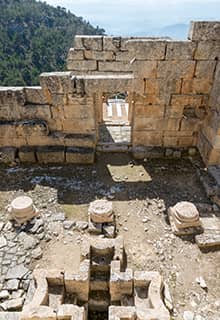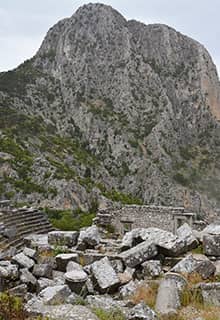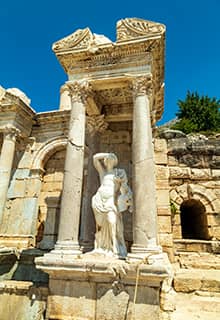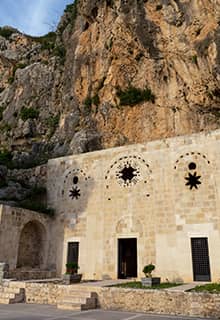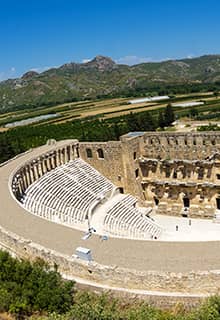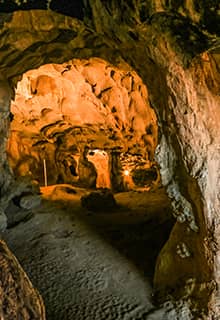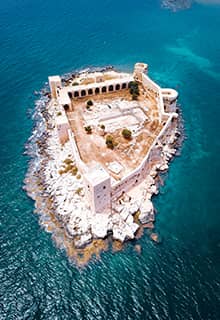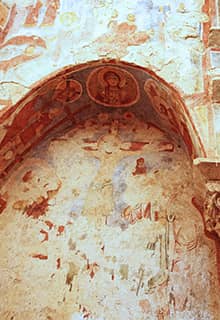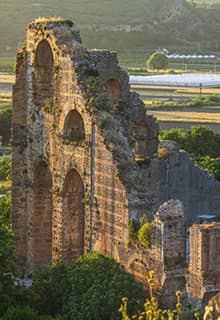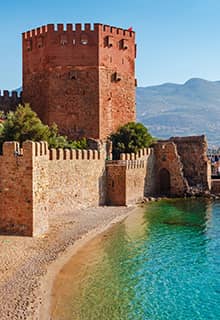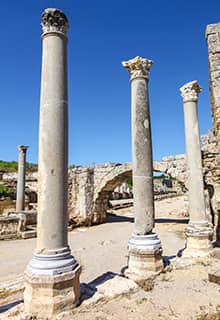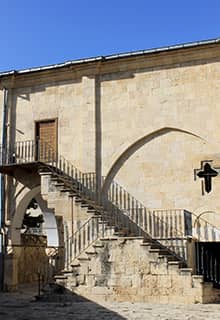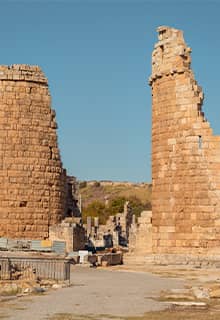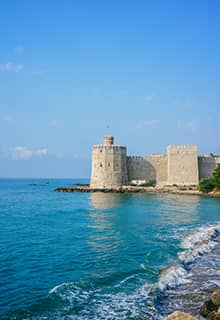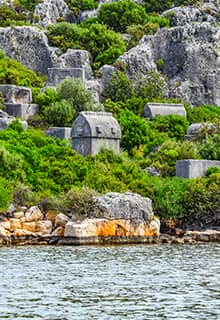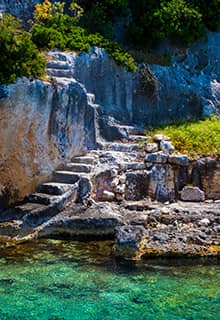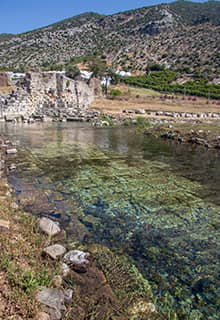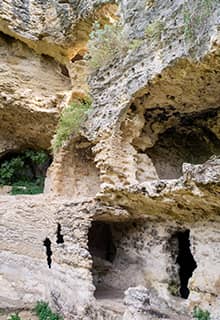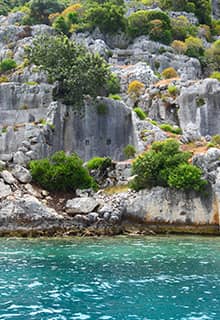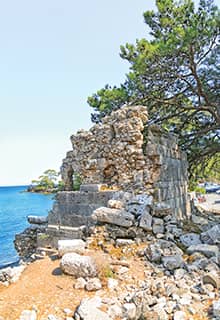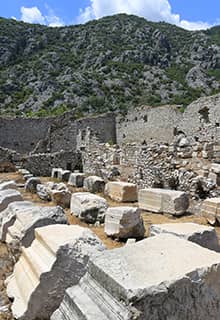

Mediterranean Türkiye
UNESCO Heritage Sites and Routes
Karain Cave, Antalya
UNESCO World Heritage Tentative List 1994
Karain Cave lies 35 km north of Antalya. It is one of the six caves with evidence of prehistoric settlement discovered in this region, indicating the importance of early human activity in the area. The cave attracts interest with the paleolithic findings discovered here. Excavations have shown that settlement here began as early as 700000 BC with Homo erectus, and continued uninterruptedly through the whole Paleolithic Age as late as Byzantine times. A fragment of a Neanderthal skull was also unearthed here and is now on display at the Antalya Museum. Paleolithic and Neolithic flint blades, scrapers, and arrowheads were also discovered. The attention of researchers was especially drawn to the carving of a human face, stylistically similar to the artifacts of the Natufian culture which flourished in the Levant during the Mesolithic period.
Alahan Monastery, Mersin
UNESCO World Heritage Tentative List 2000
Alahan Monastery is situated around 100 km north of Silifke, in the Taurus Mountains. The area’s natural scenery is spectacular and adds to the majesty of the monastery. In antiquity, the area was known as Cilicia, and the Cilician Gates (Gülek Pass), a pass through the Taurus Mountains connecting the low plains of Cilicia to the Anatolian Plateau, were a famous landmark. Although Alahan Monastery is not located on the Cilician Gates, it was located some 100 km east, on another main route that also provided access to the hinterland from the Mediterranean through the Sertavul Pass. This mountain pass was on the road from Konya (ancient Iconium) over Karaman (ancient Lanarda) to the Mediterranean coast.
Alanya Castle and Dockyard, Antalya
UNESCO World Heritage Tentative List 2000
Alanya is a famous resort town on the Mediterranean, accessible both via Antalya Airport and Gazipaşa-Alanya Airport. Alanya is located on the ancient borders of Cilicia and its ancient name was Korakesion. Very little survives from this early period, but much more has made it to our days from the Seljuk period. In the Seljuk period, Alanya was called “Alaiye” and especially during the 13th century, it was the main Seljuk city on the Mediterranean. Alanya Castle, a Seljuk-era citadel dating back to 1226, dominates the whole city and is the main historical attraction. Most major landmarks in the city are found inside and around the castle. In various sections of the castle area there are a Byzantine church, the Süleymaniye Mosque and caravanserai, and the old city walls that surround much of the eastern peninsula. The Kızıl Kule (Red Tower), the city’s symbol, is a tall brick building standing at the harbor below the castle. It currently houses the Ethnographic Museum of Alanya. The Alanya Tersane (Dockyard), which is protected by the defensive walls, remains one of the finest examples of medieval military architecture. The dockyard is divided into five vaulted bays with equilateral pointed arches, and was built in the 3rd century AD.
Güllük Dağı -Termessos National Park, Antalya
UNESCO World Heritage Tentative List 2000
Termessos is perhaps one of the most attractive and impressive ancient cities not only in Türkiye, but in the entire world. The Güllük Dağı -Termessos National Park (Mount Güllük- Termessos National Park) adds to its unique beauty. Termessos can be reached easily from Antalya with a 35 km drive northwest along the Denizli-İzmir road. The name “Temessos” and the ancient name of Mount Güllük (Solymos) derived from “Solymeus,” an Anatolian god who in later times came to be identified with Zeus. The people of Termessos in fact noted, “We are neither Pisidian nor Lycians, but we are Solymians” referring to their sacred mountain and to the main deity of the city, Zeus Solymeus. Alexander the Great failed to capture the city in AD 333, likening it to an eagle’s nest. Alexander did not even attempt to lay siege to it, preferring instead to march on. The historian Arrian of Nicomedia discussed how even a small force could defend Termessos due to its excellent natural fortifications. Since until recently there were no modern settlements or roads leading up the city, most buildings are, for the most part, intact and give visitors a strong sense of walking back in time.
At least half a day is necessary to visit Termessos. The site is huge with, among others, four cemeteries containing beautiful examples of Pisidian tombs; a theater with an amazing view of Mount Solymos and a seating capacity of 4,000-5,000 spectators; a bouleuterion from the Hellenistic period standing at its original height; impressive cisterns and water systems; temples; baths; and colonnaded streets. Not to mention the impressive landscape and forests.
Kekova, Antalya
UNESCO World Heritage Tentative List 2000
Kekova is the name of an area rather than a town or ancient city. It is located approximately 200 km west of Antalya and 250 km east of Fethiye. Kekova is an ensemble of picturesque islands and numerous bays. Along the northern shore of Kekova Island earthquakes have caused ancient houses to sink under the clear water, creating a sunken city. No swimming or diving is allowed at the site; however, you can see the ruins from a boat. The whole area is full of ancient ruins from the Lycian period. The ruins of the ancient Lycian city of Simena overlook Kekova Bay and are situated below the ramparts of a Roman castle which houses a small theater cut into the rock. A climb to the summit, will give you a bird’s-eye view of the bays, inlets, island, and yachts sailing on the glassy water. On the distance you will see numerous sarcophagi scattered on the hills. On the other side there is the picturesque village of Üçağız, once an ancient Lycian city called “Theimiussa” - both names mean three mouths, referring to the opening of the inlet to the sea via three openings.
St. Nicholas Church, Demre, Antalya
UNESCO World Heritage Tentative List 2000
“At the west edge of the village of Demre is the famous church of St. Nicholas of Myra, the goal in former times of pilgrims, now of tourists,” writes Prof. George Bean. St. Nicholas of Myra was born in Patara, according to tradition, on March 15, 270 and became Bishop of Myra. He was famous for the miracles he performed, which earned him the name “Nicholas the Wondermaker.” He is the patron saint of Greece and Russia, as well as the patron saint of children, merchants, sailors, and scholars, among many others. Although little is known of the historical Saint Nicholas, there is little doubt that he lived and died at Myra. St. Nicholas Church in Demre is an ancient East Roman church dedicated to the saint and believed to be built above the burial of St. Nicholas. It has been excavated by Turkish archaeologists and a roof has been added to protect the structure. The saint’s sarcophagus is located inside the church and has Cyrillic inscriptions on it, carved during the restorations carried out by Russians in the 19th century. In the 11th century, the sarcophagus was desecrated by a group of merchants who took part of the saint’s remains to their hometown of Bari, Italy – thus, the saint is also known as "Nicholas of Bari." However, St. Nicholas is probably most famous across the world for the historical inspiration behind “Santa Claus.”
St. Paul Church, St. Paul’s Well, and Surrounding Historic Quarters, Tarsus
UNESCO World Heritage Tentative List 2000
St. Paul, or Paul the Apostle, is perhaps one of most important figures of early Christianity. Paul was born to a Jewish family in Tarsus, a town in southern Türkiye, between Mersin and Adana. In the Bible, he is mentioned as “Saul (Paul) of Tarsus.” St. Paul is considered one of the most important figures of the Apostolic Age and his influence on both Western and Eastern Christianity is profound. In 1704, P. Lucas wrote that there was a church in Tarsus that had been built by Paul, and V. Langlois visited Tarsus in 1851 and confirmed this. According to tradition, St. Paul Church dates back to the 11th century. However, the present structure, a domeless basilica, dates to the mid-19th century. The sides of the central nave window were once decorated by angels and landscape depictions. On the ceiling there are frescoes of Jesus, in the middle, and Matthew, Mark, Luke, and John, on the two sides. Besides the church, other important sites include the historical well, known as “St. Paul’s Well,” the ancient street, and the ancient arched Roman gateway.
Ancient Cities of Lycian Civilization, Antalya
UNESCO World Heritage Tentative List 2009
The ancient cities of Lycia are situated on the Teke Peninsula, roughly between Antalya and Fethiye. The first settlement of the area dates back to Paleolithic times: in the Karain Cave the settlement began around 700000 BC and lasted until Byzantine times. Also, Beldibi Cave which dates to 35000 BC, is contemporary with Lascaux and Altamira at France and Spain. Urban settlements began here in the Bronze Age (3000-1200), and are best represented the settlements of Elmali, Tlos, and Hacilar. Sources dating back to the 2nd millennium BC mention a tribe called "Luka" or "Lukka," and Hittite King Suppiluliuma mentions his conquest of the "Lycia Country" in the 14th century BC. According to historians, "Lukka" means "Land of the Light." In the Iliad, Homer mentions the Lycians as brave warriors in the Trojan War, as allies of King Priam, and that they came all the way from Lycia, from the eddying Xanthos River. Today, we know that the Lycians were native Anatolians, who spoke a non-Greek language called “Lycian” that was related to Luwian, the earliest known Indo-European language, which originated in central Anatolia. The Lycians created a spectacular civilization that can be especially observed in their unique tomb designs. The Lycian Way is a 500-kilometer-long trail that crosses through Lycia and has become extremely popular in recent years. In the western part of Lycia, Tlos, Xanthos, Patara, Pinara, and Telmessos are the most important cites; in middle Lycia, Antiphellus, the Kekova area, Arycanda, Limyra, and Myra; and to the west, Olympus and Phaselis are cities that can be visited. In the middle of the 1st century BC, the Lycian League was established which comprised 23 cities. This native government was an early federation with republican principles. One of the outstanding features of the league was the system of representative government, with privileges and obligations in direct ratio to a city's classification. Its system of elected representatives was unique in the ancient world and was greatly admired both in antiquity and in the centuries that followed. In fact, the constitution of the United States of America was influenced by the Lycian federal system of government’s proportional representation.
Archaeological Site of Sagalassos, Burdur
UNESCO World Heritage Tentative List 2009
Sagalassos is located 120 km north of Antalya, on the way to İsparta. The area is especially beautiful as Lake Eğirdir of the Turkish Lake District is remarkably close. A visit to Sagalassos and Eğirdir, should also include a visit to the Burdur Archaeological Museum where all the wonderful statues and fragments of friezes are on display. The site became a major excavation center thanks to Belgian archaeologists who began work here in 1989. Sagalassos features perhaps the only ancient fountain where one can still drink water from the ancient pools - the restored Antonine Nymphaeum is a monumental fountain built during the reign of Marcus Aurelius. The Anatolian origins of the city relate back to Hittite documents that refer to the mountain site of “Salawassa” in the fourteenth century BC. The city prospered during the Hellenistic and Roman periods. It was the wealthiest and one of the most important cities in Pisidia, playing a central role in Pisidian history. The city features a public bath (thermae) and the ruins of an upper and lower city. In the lower city there are ruins of fountains and a colonnaded street. The upper city includes an agora with the restored fountain from the Roman imperial period; a heroon with a frieze depicting 14 dancing girls; a bouleuterion; a macellum, which is an ancient Roman outdoor market for provisions such as meat and fish; and a theater.
Sagalassos is situated high in the western Taurus Mountains. Due to the city’s high altitude (1,450-1,700 meters above sea level), in the winter visitors might encounter heavy snow. On the contrary, it is a wonderful place to visit in summer when it is almost always pleasantly cool.
Archaeological Site of Perge, Antalya
UNESCO World Heritage Tentative List 2009
Perge is situated approximately 20 km east of Antalya, on the main road to Alanya. The origins of the city go back to the Bronze Age. The name "Parha" is written on a Bronze Age plate in cuneiform script documenting an agreement in the 13th century BC. This name is associated with the later Greek
“Perge.” The city has been successfully excavated by Turkish archaeologists for over 70 years, and Antalya Museum holds all the magnificent findings unearthed in Perge. Thanks to these meticulous excavations, the city offers visitors a wonderful and insightful experience. The theater, the stadium, the city walls, the baths, the agora, and the colonnaded street bring the ancient city to life, giving one the feeling of traveling back in time and walking through the streets of a living city. Perge became famous for the worship of Artemis, whose temple stood on a hill outside the town, and in whose honor annual festivals were celebrated. As you enter the city through the Late Roman gate, a broad square welcomes you, with Hellenistic towers dominating it. Immediately on your left, stands the magnificent fountain attached to the baths. The Roman baths here are the best-preserved Roman baths in Türkiye. You can walk along the colonnaded street, which has been remarkably preserved, and which was once flanked by shops. The street will lead you up to the acropolis which offers a magnificent view.
Eşrefoğlu Mosque, Beyşehir
UNESCO World Heritage Tentative List 2011
Eşrefoğlu Mosque is located in Beyşehir, 90 km west of Konya and 210 km north of Antalya. Beyşehir is the principal city in the Turkish Lake District, and Lake Beyşehir is the third-largest lake of Türkiye. Beyşehir was the capital city of the Eshrefids (or Ashrafids, Eşrefoğulları in Turkish), one of the Anatolians beyliks. Eşrefoğlu Mosque was built as a part of a complex in the 13th century. The complex includes the mosque, the tomb of Süleyman Bey, and a madrassa. After seven centuries, this mosque is still used for regular services. The wooden columns are made of cedar and according to oral tradition they were soaked in Lake Beyşehir for six months before being used in the building. At the center of the mosque there is a snow pit which until relatively recent times was filled with snow from the nearby mountains. This snow cooled the mosque during the summer, and supplied the necessary humidity to the wooden structure. In 2011, the mosque was included on the Tentative List of the UNESCO World Heritage Sites. The following justification was provided for its inclusion on the list: “Eşrefoğlu Mosque includes all the main elements of early Anatolian Turkish architecture and the building is the biggest, best preserved wooden columned and roofed mosque in Islamic World.”
Mamure Castle, Mersin
UNESCO World Heritage Tentative List 2012
Mamure Castle is located in the Eastern Mediterranean, 6 km east of Anamur, on the main road from Antalya to Mersin. It is a very impressive castle in part due to the fact that it is directly on the water. The exact date of its construction is not known. However, the inscriptions on the main gate (which is not the main entrance for visitors today) states that it was built in the 15th century by Ibrahim II of Karaman, a ruler of the Karamanid dynasty. The existing building indicates the castle was built on top a fortification from the Roman period. The castle is extremely well-preserved and almost all the towers, the steps, the mosque, and the cisterns are in excellent condition. The ruins of a Turkish bath (hammam) can be found in the western courtyard. The entrance part of the hammam has been demolished but other parts are still intact.
St. Pierre Church, Hatay
UNESCO World Heritage Tentative List 2011
Antioch is situated on the Eastern Mediterranean, close to the Syrian border. The modern city of Antioch, in the Hatay Province, has always been home to various cultures and civilizations. Antioch, the ancient Antiochia, was established by the Seleucid rulers. It was an important city during the early history of Christianity, and in particular for the Syriac Orthodox Church and the Antiochian Orthodox Church. Tradition has it that St. Peter, also known as Simeon and one of the Twelve Apostles of Christ, was the first Patriarch of Antioch and founded the church of Antioch, which still serves as a pilgrimage site. The oldest surviving parts of the church building date back to the 4th or 5th century; these include some pieces of floor mosaics and traces of frescoes near the altar. The tunnel inside opens to the mountainside and is thought to have served as an evacuation route for the Christians in the case of sudden raids and attacks. The water which seeps from the nearby rocks was gathered to drink and to use for baptism; the flow of this water, which visitors drank and collected to give to those who were ill, has lessened as a result of recent earthquakes. During the First Crusade in the 11th century, the church was lengthened by a few meters. Acting on the orders of Pope Pius IX, Capuchin Friars restored the church and rebuilt the facade in 1863. The French Emperor Napoleon III also contributed to its restoration. The church’s garden has been used as a cemetery for hundreds of years. There are also tombstones inside the church, especially around the altar. The church is the burial place of Tancred, Prince of Galilee, and one of the three final resting places of the remains of the Holy Roman Emperor Frederick Barbarossa, who died in the Third Crusade.
Gastronomy, Hatay
UNESCO Creative Cities Network
Hatay was designated as a city of gastronomy by the UNESCO Creative Cities Network in 2017. Situated in southern Türkiye, at the heart of the Amik Valley, Hatay displays a multicultural identity inherited from its location on the ancient Silk Road. Hatay served as the entrance gate of the Silk Road to the Mediterranean and has been the center of spice trade for centuries. With its mild climate, the region encompasses an extremely rich flora, allowing for the growth of medicinal and aromatic plants, an industry which now provides 60% of Hatay’s GDP. Hatay City Council, along with associations and NGOs, co-organizes many gastronomy-themed festivals and events to promote the diverse local food culture and agriculture, including the Hatay Agriculture Fair and the Hatay Künefe Festival. Considering gastronomy as a tool for social inclusion, the city undertakes several initiatives to empower women by creating new employment opportunities. In addition, with the strong support of the municipality, the Down Café was established in 2016 to create socially inclusive employment, with all employees being people with disabilities as well as volunteers. The Metropolitan Municipality undertakes a series of policies and strategies to protect and promote the diverse food culture further, as well as the rich flora through farming incentives and microcredits. The municipality supports specialized organizations such as the Hatay Cooks and Confectioners Society which focuses on healthy nutrition, organic agriculture, and food safety. The city also promotes trainings for farmers in horticultural therapy, permaculture, high-tech farming, and biodiversity in order to raise awareness of sustainable food systems.
Ancient City of Anazarbos, Adana
UNESCO World Heritage Tentative List 2014
Anazarbos (Anazarbus) is located 30 km south of the district of Kozan in Adana. The settlement has had different names throughout its long history. In AD 19, the city of Anazarbos was founded during the Roman emperor Augustus’s visit and it was dedicated to the emperor under the name “Kaisareia.” Today, the city is called “Anavarza” and it can be easily reached from Adana. One should be prepared for a steep climb after visiting the ruins scattered around the modern village of Dilekkaya, as the medieval castle on the top of the hill is worth visiting. The view over the Çukurova Plain that dominates the whole area is magnificent. Anazarbos was inhabited interruptedly for more than 2,000 years, and displays the cultural traces of many significant civilizations of Anatolia such as the Romans, Byzantines, Arabs, Armenians, and Ottomans.
Ancient City of Korykos, Mersin
UNESCO World Heritage Tentative List 2014
Along the coastline of the East Mediterranean, the province of Mersin is full of ancient monuments. Perhaps one of the most appealing is the ancient city of Korykos (also Corycus), known in Turkish as “Kız Kalesi,” literally "Maiden Castle." The ancient city is at 65 km from Mersin and lies alongside the northeast and southwest axis reaching Elaiussa-Sebaste in the east and Cennet-Cehennem Çökükleri in the west. A town by the name of “Corycus” is mentioned by Livy and Pliny, and the city was in important ancient harbor and commercial center. The ruins of the ancient city have been excavated in recent years and several monuments have been unearthed including a theater. The two medieval castles, one on the shore and the other on the islet (Kız kalesi), were once connected by a pier.
Vespasianus Titus Tunnel, Antakya
UNESCO World Heritage Tentative List 2014
The Vespasianus Titus Tunnel is an ancient water tunnel built in the Roman period. It is located within the boundaries of the ancient city of Seleuceia Pieria, near the village of Çevlik, 35 km to the southwest of Antakya, the historical city of Antiochia. During the early Roman period, Antiochia flourished and became one of the most important ports of the Eastern Mediterranean. Since the city was threatened by floods from water descending from the mountains and the harbor was silted up and had become inoperative, the Roman Emperor Vespasianus (Vespasian) ordered the construction of a water diversion system. The tunnel, built by digging the mountain, was meant to divert the floodwaters threatening the harbor. The diversion system was based on the principle of closing the front of the streambed with a deflection cover and transferring the stream waters to the sea through an artificial canal and tunnel. The construction began in the 1st century AD and was completed in the 2nd century AD. A rock-carved inscription at the entrance of the first tunnel section bears the names Vespasianus and Titus, another inscription in the downstream channel that of Antonius. The diversion system, displaying a broken alignment, consists of a dam to divert the river flow; a short approach channel; the first tunnel section; a short intermediary channel; the second tunnel section; and a long discharge channel.
Eshab-i Kehf Külliye, Kahramanmaraş
UNESCO World Heritage Tentative List 2015
Eshab-i Kehf (Seven Sleepers) is a widely known legend both in Islam and Christianity that has inspired the construction of several complexes. The one in Kahramanmaraş is next to a cave on the hill Bencilus, approximately 7 km from Afşin district and 130 km from Kahramanmaraş. The complex (külliye) is composed of several buildings built in different eras. The church was built in the 6th century AD. During the Seljuk period, a mosque, a caravanserai, and a fortified barracks were added. Later, during the Anatolian beylik of Dulkadir, a madrassa (religious school) was added. In the beginning of the 16th century, a women's mosque was built. According to the legend, seven young boys and their dog fell asleep in a cave to avoid prosecution and woke up 300 years later. Several sites are credited as the cave where the seven sleepers slept; one of the most famous is the “Grotto of the Seven Sleepers” at Ephesus.
The Theatre and Aqueducts of the Ancient City of Aspendos, Antalya
UNESCO World Heritage Tentative List 2015
The ancient city of Aspendos is located 40 km east of Antalya, on the Köprüçay River, which in antiquity was called the Eurymedon. Eurymedon River was famous in ancient times because of the Battle of the Eurymedon (5th century BC) between the Greeks and their allies and the Persian Empire of Xerxes I. The battle is known as the first battle that took place both on water and land. Today, the site is primarily famous for the splendid Roman theater - not only the best-preserved theater of the Roman period, but also the best designed theater of the same period. The Seljuk Turks renovated the ancient theater about a thousand years after it was built to use as a caravanserai and a palace. This renovation helped the theater reach our days almost intact. The theater at Aspendos is the only example of an ancient theater where the stage building is still standing at its original height with only the statues in the niches missing. Other important structures include the great basilica, the agora, the fountain, the aqueducts, and the two unique siphon systems which have been a source of fascination for archaeologists.
Ancient City of Kibyra, Burdur
UNESCO World Heritage Tentative List 2016
Kibyra lies north of Lycia and was the provincial capital of the district of Cibyratis, a confederation of towns that was created in the 2nd century BC. The confederation was formed by four cities: Kibyra, Boubon, Balboura, and Oinionda. Strabo, the Greek geographer, claimed that the residents of Kibyra were the descendants of the Lydians, the indigenous people of this part of Asia Minor. It is known that four languages were used in the federation as its members spoke Lydian, Greek, Pisidian, and Solymi. Kibyra was the last place in Anatolia where the traces of Lydian culture, long forgotten in other parts of the region, could be found. An important source of income for the residents of Kibyra was metallurgy. The city minted its coins from the mid-1st century BC until the reign of Emperor Gallienus in the middle of the 3rd century AD.
Yivli Minaret Mosque, Antalya
UNESCO World Heritage Tentative List 2016
The Yivli Minaret Mosque with the snowcapped Taurus Mountains in the background is definitely Antalya’s best-known silhouette. The mosque is located at the main entrance to Kaleiçi, Antalya’s Old Town, and is a landmark and symbol of the city. Yivli Minaret literally means “fluted minaret” and refers to the 38-meter-high minaret which is decorated with dark blue tiles. The original mosque was built in 1230 on the ruins of an old church. It was destroyed in the 14th century and the prayer hall was rebuilt with six domes. The building is one of the oldest examples of multidomed mosques in Anatolia. The mosque is famous for its minaret which was constructed on the orders of Alaaddin Keykubad I, the Seljuk sultan who ruled between 1220 and 1237. The fluted minaret, which is free-standing with eight fluted sections, is a unique example of Anatolian Turkish architecture.

